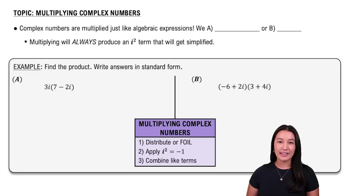Here are the essential concepts you must grasp in order to answer the question correctly.
Complex Numbers
Complex numbers are numbers that have a real part and an imaginary part, expressed in the form a + bi, where a is the real part, b is the imaginary part, and i is the imaginary unit defined as the square root of -1. Understanding complex numbers is essential for performing operations such as addition, subtraction, multiplication, and division.
Recommended video:
Multiplication of Complex Numbers
To multiply complex numbers, you apply the distributive property (also known as the FOIL method for binomials) to combine the real and imaginary parts. For example, when multiplying (a + bi)(c + di), you calculate ac, ad, bc, and bd, and then combine like terms, remembering that i^2 = -1 to simplify the result.
Recommended video:
Multiplying Complex Numbers
Standard Form of Complex Numbers
The standard form of a complex number is expressed as a + bi, where a and b are real numbers. When performing operations on complex numbers, the final result should be simplified to this form, ensuring that the real and imaginary components are clearly separated for clarity and further calculations.
Recommended video:
Complex Numbers In Polar Form
 Blitzer 3rd Edition
Blitzer 3rd Edition Ch. 5 - Complex Numbers, Polar Coordinates and Parametric Equations
Ch. 5 - Complex Numbers, Polar Coordinates and Parametric Equations Problem 1
Problem 1 Verified step by step guidance
Verified step by step guidance


